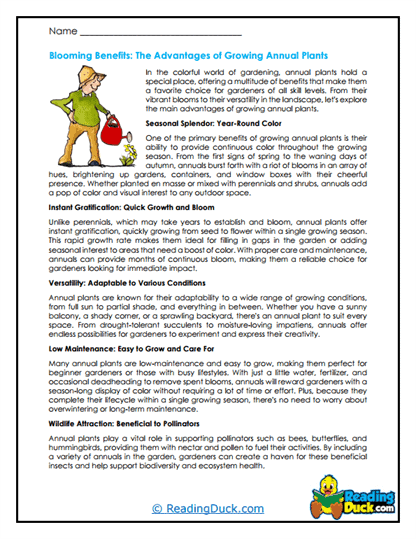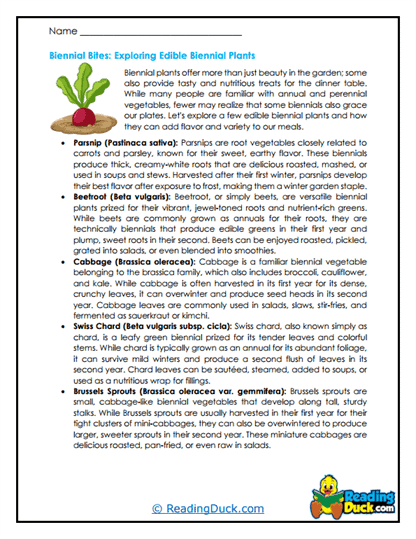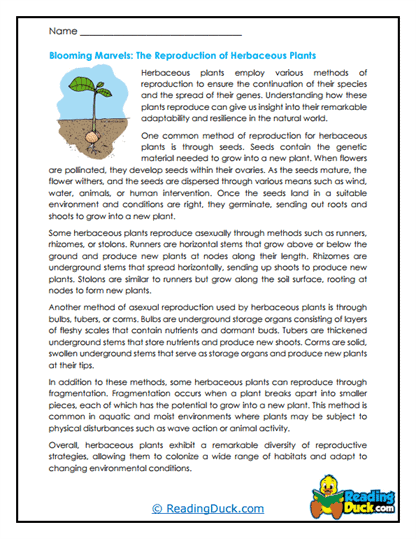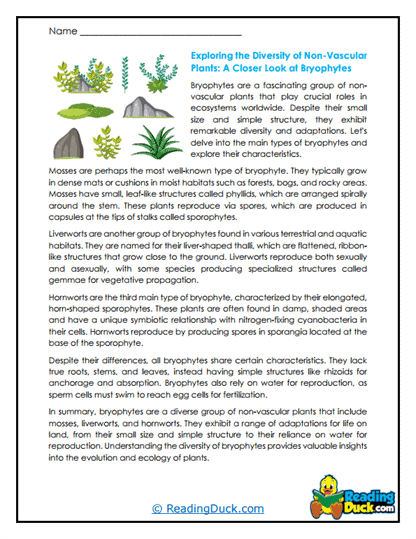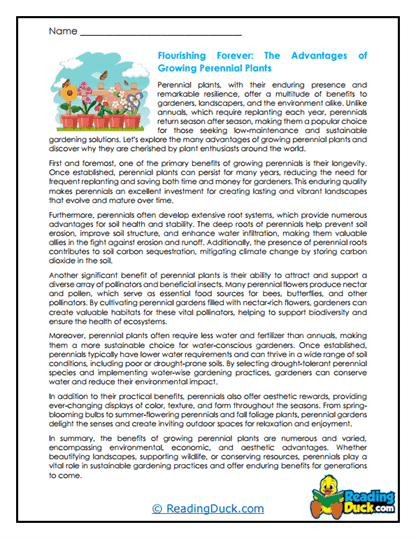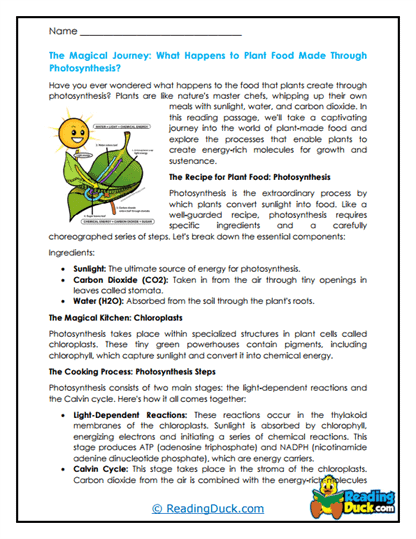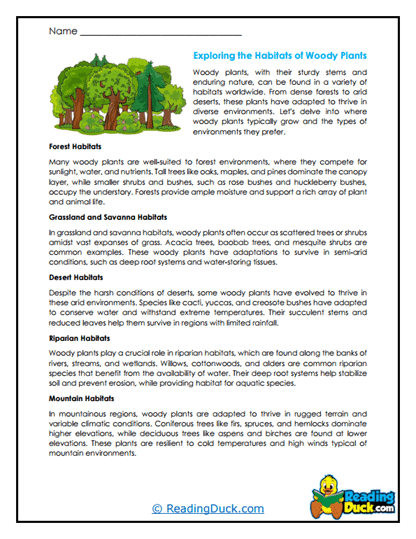Plants Worksheets
About Our Plants Worksheets
Our Plants Worksheets provide a comprehensive and engaging exploration of the plant kingdom, a fundamental topic in the study of Biology. This collection delves into various aspects of plant life, helping students understand the diversity, structure, and essential functions of plants. From the smallest mosses to the tallest trees, these worksheets guide students through the fascinating world of plants, fostering a deeper appreciation for the role plants play in our environment and daily lives.
This collection is a subtopic within Biology and is further categorized into several specific areas: Annuals, Biennials, Herbaceous Plants, Herbs, Non-vascular Plants, Parts of Plants, Perennials, Photosynthesis, Vascular Plants, and Woody Plants. Each of these categories contains multiple worksheet sets designed to enhance students' knowledge and understanding.
Each worksheet set includes:
- Multiple Choice Questions: These questions assess students' comprehension of the reading material, ensuring they grasp the key concepts and details presented.
- Short Answer Questions: This section encourages students to articulate their understanding in their own words, reinforcing their knowledge and improving their ability to communicate scientific information effectively.
- Open-Ended Questions: These questions invite students to share their personal thoughts, opinions, and reflections on the material, fostering deeper engagement and critical thinking.
Answer keys are provided for every question sheet, making it easy for educators and parents to review students' work. All worksheets are available in PDF format, allowing them to be easily viewed electronically, downloaded, and printed for use in various educational settings.
Exploring the World of Plants: An In-Depth Look
Plants are vital to life on Earth, serving as the foundation for most food chains and playing a crucial role in the global ecosystem. When introducing students to the study of plants, it’s essential to cover the different types, life cycles, structures, and processes that define plant life. Here’s a detailed breakdown of the key aspects of plants covered in this collection:
Annuals, Biennials, and Perennials: These categories classify plants based on their life cycles.
- Annuals: Annual plants complete their entire life cycle—from germination to seed production—within a single growing season. Examples include many flowers and vegetables like marigolds and tomatoes. Students will learn about the advantages and disadvantages of annual plants in both natural ecosystems and agricultural settings.
- Biennials: Biennial plants require two years to complete their life cycle. In the first year, they typically grow leaves, stems, and roots, and in the second year, they flower, produce seeds, and die. Examples include carrots and parsley. Understanding biennials helps students appreciate the varied strategies plants use to survive and reproduce.
- Perennials: Perennials live for more than two years, often going dormant during unfavorable seasons and resuming growth when conditions improve. Examples include trees, shrubs, and many herbaceous plants. Students will explore how perennials contribute to stable ecosystems and their significance in landscaping and agriculture.
Herbaceous Plants and Herbs: These categories focus on plants that have non-woody stems.
- Herbaceous Plants: These plants are characterized by soft, green, and flexible stems. They may be annuals, biennials, or perennials. Students will learn how herbaceous plants adapt to various environments and their roles in food webs and human agriculture.
- Herbs: While commonly thought of as culinary ingredients, herbs encompass a wide range of plants used for flavoring, medicine, and fragrance. Examples include basil, mint, and rosemary. Students will explore the cultural and historical significance of herbs, as well as their uses in modern cooking and medicine.
Non-Vascular and Vascular Plants: These categories help students understand the evolutionary advancements in plant structure.
- Non-Vascular Plants: These plants, such as mosses and liverworts, lack specialized tissues for transporting water and nutrients. They are typically found in moist environments. Students will learn about the life cycles of non-vascular plants, their ecological roles, and their significance as some of the earliest forms of plant life on Earth.
- Vascular Plants: Vascular plants have specialized tissues—xylem and phloem—that transport water, nutrients, and food throughout the plant. This category includes everything from ferns to flowering plants and trees. Understanding vascular systems helps students appreciate how these plants have adapted to a wide range of environments and how they support the vast diversity of plant life on Earth.
Parts of Plants: This category delves into the structure and function of different plant parts.
- Roots: Roots anchor plants in the soil and absorb water and nutrients. Students will learn about the different types of roots, such as taproots and fibrous roots, and their functions in plant growth and stability.
- Stems: Stems support the plant and transport nutrients and water between the roots and leaves. Students will explore the different types of stems, including herbaceous and woody stems, and their roles in plant physiology.
- Leaves: Leaves are the primary sites of photosynthesis, where plants convert sunlight into energy. Students will learn about leaf anatomy, including the role of stomata in gas exchange, and how leaves are adapted to various environments.
- Flowers: Flowers are the reproductive organs of many plants, producing seeds for the next generation. Students will explore the structure of flowers, including the roles of petals, stamens, and pistils, and how pollination occurs.
Photosynthesis: This crucial process is how plants produce energy from sunlight.
- The Process of Photosynthesis: Students will learn about the chemical reactions involved in photosynthesis, including the roles of chlorophyll, carbon dioxide, and water. Understanding photosynthesis is fundamental to grasping how plants produce food and oxygen, supporting life on Earth.
- Factors Affecting Photosynthesis: Students will explore how factors such as light intensity, carbon dioxide levels, and temperature influence the rate of photosynthesis. This knowledge helps them understand plant growth and productivity in different environments.
Woody Plants: This category covers trees, shrubs, and other plants with woody stems.
- Types of Woody Plants: Students will learn about the different types of woody plants, including deciduous and evergreen trees, and how these plants are adapted to their environments. They will explore the structure of woody stems, including the role of bark and the annual growth rings in trees.
- Ecological Importance of Woody Plants: Woody plants play crucial roles in ecosystems, providing habitat, food, and oxygen. Students will learn about the significance of forests and woodlands in maintaining biodiversity and their importance in the carbon cycle.
By studying these aspects of plants, students gain a comprehensive understanding of the diversity, structure, and functions of plants. The worksheets help break down complex concepts into engaging and accessible material, fostering curiosity and a deeper appreciation for the plant kingdom.
How Students Can Use These Worksheets
Here are five tangible ideas on how teachers and parents can use these Plants Worksheets in school or in a homeschool setup in effective, productive, and creative ways:
- Plant Growth Experiment: Have students plant seeds of different types of plants—annuals, biennials, and perennials—and observe their growth over time. They can use the worksheets to document their observations, track the stages of plant development, and compare the life cycles of different plants. This hands-on activity reinforces the concepts of plant life cycles and growth.
- Herb Garden Project: Encourage students to start their own herb garden, either in pots or in a small garden bed. They can use the worksheets to learn about different herbs, their uses, and how to care for them. This project combines science with practical gardening skills and can be extended to include cooking with the herbs they grow.
- Photosynthesis Simulation: Conduct an experiment where students explore the factors affecting photosynthesis. For example, they can grow plants under different light conditions or vary the amount of water they receive. Using the worksheets, students can record their findings and analyze how these factors influence plant growth and photosynthesis rates.
- Tree Identification Walk: Take students on a nature walk to identify different types of woody plants, such as trees and shrubs, in their local environment. Using the worksheets, students can document the characteristics of the plants they find, including leaf shape, bark texture, and overall structure. This activity encourages observation skills and a deeper connection to the natural world.
- Plant Parts Investigation: Have students collect various plant parts—roots, stems, leaves, flowers—and examine them closely, either with a magnifying glass or under a microscope. They can use the worksheets to label the parts, describe their functions, and explore how each part contributes to the plant's survival and reproduction. This activity deepens their understanding of plant anatomy and physiology.
The Importance of Learning About Plants
Learning about plants is crucial for students on both an academic and personal level. Academically, it provides a foundation for advanced studies in biology, botany, agriculture, and environmental science. It also enhances critical thinking and observational skills as students explore the diversity and complexity of plant life and the essential processes that sustain it.
On a personal level, knowledge of plants empowers students to appreciate the natural world and understand the vital roles plants play in our lives, from providing food and oxygen to supporting ecosystems and biodiversity. Understanding how plants grow, reproduce, and interact with their environments helps students make informed decisions about environmental stewardship and sustainability.
Overall, these Plants Worksheets offer a valuable resource for educators and students alike, providing a detailed and engaging exploration of the plant kingdom. Through these activities, students can deepen their understanding of plants and develop a greater appreciation for the importance of plants in our world.
